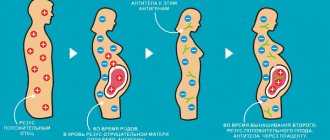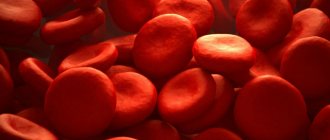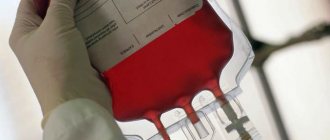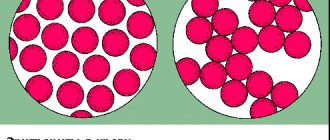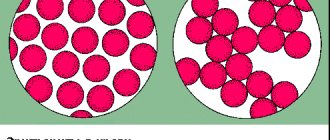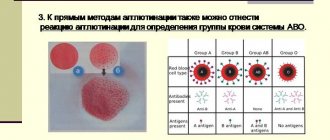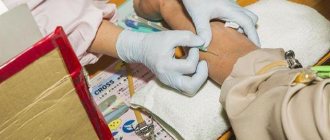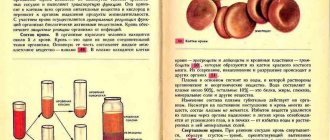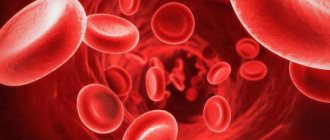October 22, 2012
There are eight blood types, which are determined by the presence or absence of certain antigens. Why is it necessary to know yours?
Different people have approximately the same blood composition: it contains the same basic elements. However, there are eight types of blood
, which are determined by the presence or absence of certain antigens.
These substances can cause a reaction from the immune system if they are foreign to it. Blood is divided into four groups according to the type of antigens
, as well as into two large groups
according to the presence of the Rh factor
.
How were blood groups discovered?
Experiments with transfusions of blood or its components have been carried out for hundreds of years.
For some, this treatment saved their lives, but most patients died after the transfusion. The reasons for this remained unknown until 1901, when the Austrian physician Karl Landsteiner discovered differences between blood samples from different people. How to become a donor?
Who can become a donor, how safe is it and how to prepare for blood donation? The answers to these and other questions are in the article on blood donation.
Thus, during experiments, Landsteiner noticed that in some cases mixing the blood of two patients can lead to agglutination - the clumping of red blood cells.
It turned out that it is this process that leads to fatal consequences. As it turned out, incompatibility of blood from different people is caused by the response of the immune system. If the recipient has antibodies against donated blood cells, the immune system tries to get rid of the foreign cells. The work of Karl Landsteiner made it possible to identify four blood groups and make blood transfusions safe
.
For this discovery, the scientist was awarded the Nobel Prize in Physiology or Medicine in 1930.
Distinguishing Antigones in humans
Antigens are present not only in red blood cells, but also in other cellular elements of the blood:
- Platelets. They are similar to epitopes (part of an antigen molecule) of erythrocytes, but the severity of their reactions is reduced during research, so they are not used in laboratories to determine the characteristics of the material.
- Plasma proteins. More than ten varieties of them have been found.
- Nuclear cells , especially lymphocytes. The discovery of antigens of these cells made it possible to increase the safety of tissue and organ transplantation, and to make a number of discoveries in genetics (the field of hereditary diseases).
The number and characteristics of the set of specific proteins vary from person to person, but some rare blood types are more common in certain countries of the world. For example, there are more Kell-positive people in England (8.66%).
What are blood groups?
The difference between the blood of different people lies in the presence or absence of certain protein molecules
called
antigens
.
They are located on the surface of red blood cells, erythrocytes and in the blood serum. It is these proteins that are responsible for the immune system’s reaction to “foreign” blood. The combinations of these molecules vary from person to person. They depend on the genetic information that people inherit from their parents. The blood group is determined by the presence or absence of two antigens A and B on the surface of red blood cells and antibodies to them in the blood plasma. In Russia, it is usually customary to name blood groups by numbers
: first, second, third and fourth.
In international practice, the designation of blood group follows the AB0
: 0 - First group, A - second group, B - third group, AB - fourth group.
- The first (0) blood group has antibodies A and B only in the blood plasma.
- The second (A) group has antigen A on the surface of red blood cells and antibodies B in the blood plasma.
- The third (B) group has antigen A in the blood plasma and antibodies B on the surface of red blood cells.
- The fourth (AB) group has A and B antigens on the surface of red blood cells.
Other group classifications
The discovery of unexpected group incompatibility in all the tests performed continues to develop and does not stop research into the meaning of different erythrocyte antigens.
- The Kell system takes third place in identification after Rhesus, takes into account 2 antigens “K” and “k”, and forms three possible combinations. Important during pregnancy, the occurrence of hemolytic disease of the newborn, complications of blood transfusion.
- Kidd system - includes two antigens associated with hemoglobin molecules, provides three options, is important for blood transfusion.
- Duffy system - adds 2 more antigens and 3 blood groups.
- The MNSs system is more complex, includes 9 groups at once, takes into account specific antibodies during blood transfusion, and clarifies pathology in newborn babies.
The definition is shown taking into account different group systems
The Vel-negative group was discovered in 1950 in a patient suffering from colon cancer. She had a severe reaction to a repeat blood transfusion. During the first transfusion, antibodies to an unknown substance were formed. The blood was of the same Rhesus group. The new group began to be called “Vel-negative”. It was subsequently found that it occurs with a frequency of 1 case in 2.5 thousand. Only in 2013, an antigen protein called SMIM1 was discovered.
In 2012, joint research by scientists from the USA, France and Japan identified two new protein complexes of the erythrocyte membrane (ABCB6 and ABCG2). In addition to their antigenic properties, they transport electrolyte ions from outside to inside cells and back.
In medical institutions it is not possible to find out blood groups based on all known factors. Only group affiliation in the AB0 system and the Rh factor are determined.
Rh factor
In addition to antigens A and B, many people also have the so-called Rh factor on the surface of their red blood cells. This is also an antigen that is shared by 85 percent of Europeans and 99 percent of Asians. Such people are called Rh positive or RH+
.
Those who do not have the Rh factor in their blood are called Rh negative or RH-
. If blood is transfused from a person with a negative Rh factor to a person with a positive Rh factor, no problems arise. Otherwise, Rh antibodies begin to be produced in the recipient’s blood, which lead to the destruction of red blood cells. Taking into account the presence of the Rh factor, a total of eight blood groups are obtained: 0 Rh+, 0Rh-, A Rh+, A Rh-, B Rh+, B Rh-, AB Rh+, AB Rh-.
Nutrition
The irrepressible passion of representatives of the third positive group for everything “delicious, sweet, spicy” and the desire to pamper themselves with a loved one can create health problems such as digestive disorders, intestinal dysfunction, the development of diabetes and obesity.
Taking into account the fact that the body of “nomads” is, in principle, omnivorous, intolerance to any product is not typical, it is easy for them to choose a diet that would be healthy, tasty and not harmful. For this purpose, the following products are recommended:
- dishes made from lean meats;
- fish and seafood dishes;
- various porridges, with a preference for rice and oatmeal;
- eggs;
- low-fat dairy products, including cheeses;
- boiled and raw vegetables in the form of salads with vegetable oil;
- drinks made from medicinal herbs (chamomile, St. John's wort, lemon balm, rose hips).
Products that are not recommended for consumption:
- pork meat, lard and fatty chicken;
- smoked meats;
- tomatoes and dishes made from them, tomato juice and ketchup;
- all kinds of sweets - ice cream, pastries, pies, sweets, they should be replaced with fruit, or light fruit cakes without baking.
Acceptable, but with restrictions: black tea and coffee, corn, legume dishes, nuts, spicy and hot seasonings. Meals should be more frequent, without waiting for feelings of extreme hunger, when overeating is often allowed.
What if you mix blood from different groups?
If the blood types of the donor and recipient are incompatible, agglutination
- the sticking together of red blood cells due to the interaction of antigens. This process occurs if, for example, a person with blood type B receives the blood of a person with blood type A. Agglutinated red blood cells clog the blood vessels and stop blood circulation. This process resembles the formation of blood clots, although it is caused by other reasons. In addition, “broken” red blood cells lose hemoglobin, which, once outside the cell, becomes toxic. This can lead to fatal consequences.
Blood type diet: expert opinion
Is it worth trying the blood type diet? Commented by Tatyana Shapovalenko, chief physician of the Treatment and Rehabilitation Center of the Russian Ministry of Health.
How many groups does a person have?
There are six human blood groups, which are of key importance in blood transfusions. But various researchers have expanded this list to 33, depending on the characteristics of protein compounds and their combinations.
In the future, the list of blood types will expand even more.
In 2012, researchers discovered two additional human blood types that also count for transfusions: Junior and Langereis. The fifth and sixth groups are most often found among Gypsies and Japanese.
In the practice of blood transfusions, the approach in which blood is divided into four types is still relevant, and rare types of blood are not taken into account in all cases, with the exception of those situations where transfusion of inappropriate material is fraught with serious complications (serious condition of the recipient, certain diseases).
Compatibility of different blood groups
Despite the difference in antigen content, in some cases, blood transfusion from a donor to a recipient with different blood groups is possible. The transfusion will be safe if the recipient does not have antibodies to the donor antigens. Thus, people with blood group 0 Rh-
are considered universal donors, since they do not have antigens or the Rh factor on the surface of their red blood cells.
AB Rh+
blood group are considered universal recipients, since their blood plasma does not contain a single antibody to the antigen and contains the Rh factor.
The influence of blood on character and lifestyle
Holders of the third positive blood group delight everyone with their easy-going and open character.
They quickly find a common language with other people, make new acquaintances and do not lose confidence and optimism even in very difficult situations. They have a strong sense of justice and stand up not only for their relatives, but also for strangers. People with such blood were greatly influenced by their historical origins from nomads, who are always in search of something new and make unexpected decisions, easily adapt to different conditions around them, such people have no constancy.
People with positive blood type 3 are suitable for creative professions, which is explained by their restless nature.
Men are characterized by such qualities as wit, charm, and assertiveness. The peculiarity of women is inconstancy, they are flighty and charming, they always have many fans. Most carriers of the third blood group have no health problems, but few suffer from dysfunction of the endocrine glands. Common pathologies are diabetes and multiple sclerosis. In many cases, people with this type of blood experience poor concentration and constant fatigue.
Complications of transfusion of inappropriate donor material
If the patient is transfused with inappropriate blood, acute hemolysis develops (destruction of red blood cells with the release of hemoglobin into the environment), in which pronounced disturbances in the coagulation processes, acute abnormalities in kidney function and circulatory shock are observed.
If the patient develops hemolysis, he requires urgent infusion therapy.
The severity of complications depends on the amount of material transfused and the health status of the recipient.
Compatibility tests
During blood transfusion, the following tests are performed:
- An individual compatibility test is carried out by mixing the recipient's serum and donor's blood in a special test tube. The result is assessed by the presence or absence of agglutination, manifested in the formation of sediment in the form of flakes;
- The Rh factor compatibility test is carried out by mixing a drop of donor blood and two drops of recipient serum. If there is agglutination, the blood is not compatible;
- A biological test is carried out just before the transfusion by administering 10-15 ml of donor blood and observing the patient for three minutes for signs of incompatibility. At the same time, the color of the skin, urine, pulse, temperature and blood pressure are assessed.
Agglutination is a sign of incompatibility
Complications
When incompatible blood is transfused, severe complications develop - transfusion shock, and later acute renal failure occurs. Their treatment is difficult and lengthy, and the prognosis may be unfavorable.
No one is immune from blood transfusion. Trauma, internal or external bleeding, complication of gastric ulcer and other acute conditions accompanied by blood loss. All of them require immediate replenishment of the main liquid tissue of our body.
It is also important to know the group and Rh factor for future parents in order to anticipate possible complications during a planned pregnancy.
